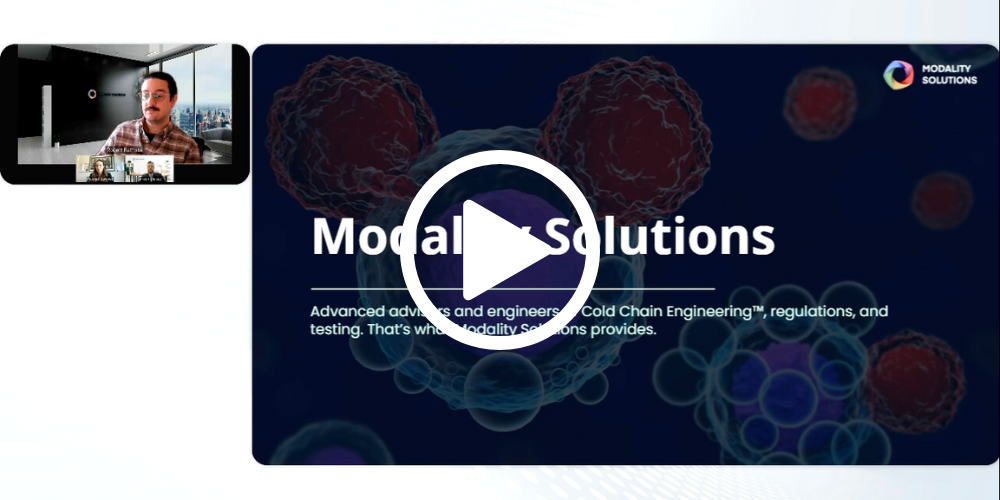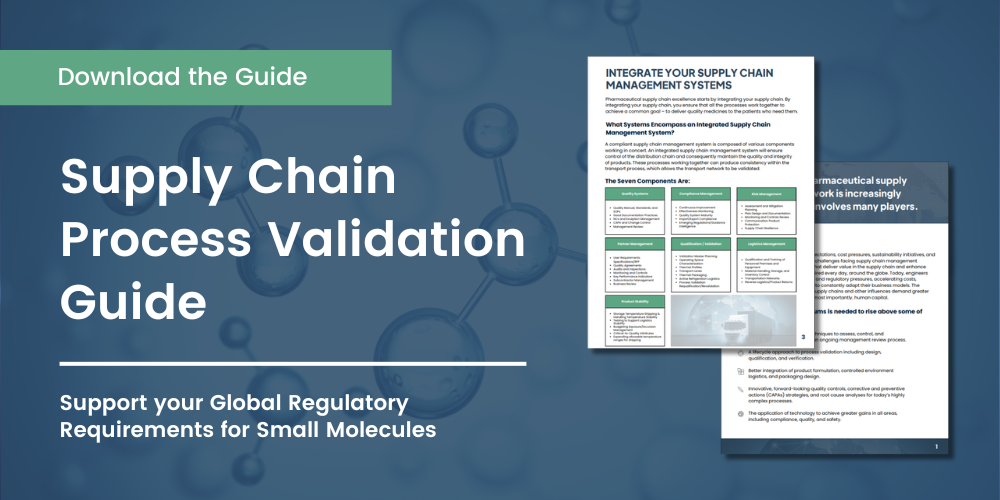Part 1: The Foundation of Pharma Supply Chain Integrity
Introduction The integrity of supply chain management is pivotal in the demanding realm of...
read Details

All pharmaceutical manufacturers must ensure that the safety and efficacy of their product is unaffected by routine shipping. While mitigating factors such as protective packaging play a role, small molecule products may still require a formal investigation into the impact of shipping on the final therapy.
The requirements of this type of study should be determined via a formal risk assessment. Following a risk-based approach, certain presentations may be less likely to need an assessment on product quality. For example, solid oral doses are more robust than a liquid formulation. However, even these products may have significant risks associated with shipping hazards.
Solid Oral Doses
Solid oral doses, tablets and capsules, are typically composed of a drug product that are highly stable and not likely to experience impacts to the critical to quality attributes (CQAs). However, other risks from shipping hazards may still apply. For example, the occurrence of chipped, broken, or leaking doses may be deemed a significant risk if these could lead to patient impacts such as mis-dosing, toxicity events, or rejected product. In such scenarios, a formal study on product quality should occur.
These studies should follow the guidelines listed under “Transport Simulation Studies” below. Post-test acceptance criteria should be pre-defined based on observable defects in the solid oral dose. These criteria must follow the defects inspected for at the manufacturer and/or packager and be tied to the Acceptable Quality Limits (AQLs) set in place at the site(s). However, these chosen AQLs should be scaled down, allowing for more defects than the manufacturer since a certain number of defects may already be present. Typical defects for inspection can include chipped or broken tablets, leaking capsules, and telescoping. Additional AQLs may be tied to vital packaging performance such as broken induction seals or label/booklet adhesion.
Liquid and Lyophilized Presentations
Liquid or lyophilized drugs are less stable than solid oral doses and therefore are more likely to require a formal investigation of product quality post-shipping. These studies should focus on the product’s CQAs and any visually observable defects that indicate quality. Examples of the latter include solution clarity or color and condition of a lyophilized cake.
For studies involving analytical testing, it is vital to ensure that the tested samples have CQA data available from both before and after the study. The assays chosen to demonstrate maintenance of CQAs should be based on the drug’s standard release panel but may omit factors that would not be impacted by transportation such as product identity.
Additionally, container closure integrity (CCI) is a rapidly evolving issue during supply chain operations. The primary packaging, be it vial, pre-filled syringe, or other, may lose its integrity due to the shock, vibration, and/or pressure fluctuations during shipment. Therefore, it is imperative to assess CCI during risk assessments and determine if generating CCI data post-shipping study is a requirement. This may also include separate studies for drug/device combination products such as pre-filled syringes and auto injectors that examine both sterility and primary functions of the device component.
Transport Simulation Testing
It is important to conduct product quality focused tests in a laboratory to ensure that the product is exposed to the expected extremes within the operating space of the transport environment. Testing the ‘edges’ of your operating space is critical to meeting the expectations of the FDA and ‘Quality by Design’ initiatives. You cannot guarantee that shipping the product in actual ‘real world’ transport conditions will test the extremes of your operating space. You may not get exposures to desired extreme transport conditions for temperature, pressure, shock, vibration, and humidity at one time, let alone concurrently.
Product transport OQ testing should be conducted using PPQ Drug Product lots or use engineering lots as conforming to the PPQ lot as possible. This GMP formulation includes having the drug product in a qualified primary packaging, which is then placed in a representative secondary packaging.
The product transport simulation test plan will subject the product to normally expected extremes in the transport environment at the edges of the operating space. It’s important to note that during actual transport, both the product and packaging are subjected to temperature, vibration, shock, pressure, and humidity changes simultaneously. The combination of these environmental transportation hazards can affect a product differently than when exposing the product to these hazards individually. Keeping this in mind, Modality Solutions has designed multi-modal Advantage Transport Simulation Laboratories that gives you the ability to concurrently simulate these five transportation hazards.
After the completion of the transport simulation test for your drug product, analytical tests should be conducted on the product to demonstrate that a dynamic transport environment does not affect product CQAs.
All supply chain professionals wish for the same magic bullet: a way to reduce costs without sacrificing quality. The number one way to do that for small molecule pharmaceuticals is to expand, or altogether eliminate, temperature requirements during shipping. This step can greatly reduce the complexity of your operations and save significant costs in the lifecycle of your product.
The information in this section is largely inspired by the work of the Parenteral Drug Association and their Technical Report number 39. This report created the term stability budget: essentially a bank of allowable hours outside of label condition for manufacturers to use across their supply chain. The PDA’s work focused largely on static stability studies, however, as Part 1 of this guide stated, there are additional factors that must be considered for shipping.
Product Stability
The first step in expanding shipping temperatures is ensuring that the product has sufficient stability data to justify the expansion. Standard stability studies should follow guidance such as the ICH Q1A(R2) guidelines and include assessment of temperature outside of label condition. For small molecules, it is common to study elevated temperatures at 40 °C or even 50 °C. Freeze/thaw or other low temperature studies should be completed.
Additionally, your product may require investigation against shipping hazards at these expanded temperatures. The impact of shipping hazards (e.g., shock, vibration, low pressure) may be enhanced when occurring outside of label conditions. Therefore, regulators may require investigating these hazards at the expanded temperature range before making the allowances. Part 1 of this guide contained recommendations on the design and execution of these studies.
Lastly, don’t forget about primary packaging and sterility! Ensure that your primary packaging components are rated for temperatures within the expanded range and conduct any testing required to show that sterility continues to be maintained within the new conditions.
Assessing Transport Lanes
The decision to expand allowable temperatures for shipping should be managed on a lane-by-lane basis. The assessment of each lane should follow a risk-based approach and vary depending on the extent of allowances.
For example, expanding the allowable temperature ranges in a lane from refrigerated to controlled room temperature would primarily require assessing the duration of the lane and the temperature controls. The duration of the lane would influence the total amount of time at the expanded temperature and the temperature controls would help ensure that excursions don’t exceed the room temperature limits.
However, we have also had success in entirely eliminating temperature control requirements in shipping lanes. In these scenarios, you must also take into account climate data within the applicable lanes. Data such as the average and extreme temperature conditions at the origin and destination sites would determine the plausibility of shipping without temperature control. Additional consideration must be given to potential differences between weather/climactic conditions and the lane temperatures as well. Either correlations based on technical standards or actual lane data can be used to demonstrate expected shipping lane conditions.
Justifying Expanded Shipping Temperatures
Coupling the product stability and shipping lane assessments, a documented technical justification must be submitted to regulators. The justification will take into account the range and durations of product stability compared to the actual conditions expected within the shipping lane(s).
The product’s stability must be determined at specific temperatures and set durations. As an example, we will take a 2-8 °C product that has 14 days of demonstrated stability up to 40 °C. Some of this may already be budgeted to other areas such as production, packaging, or patient use; however, 7 days remain that has not been previously designated.
In this scenario, you can then compare the remaining time at 40 °C to the shipping lane(s) in which expanded temperatures are desired. If the shipment will occur within a maximum of three days, you can document the comparison and justify allowing the shipment to occur at controlled room temperature conditions rather than refrigerated.
There may also be the potential to achieve the removal of temperature control in this scenario. For this, you would follow the same process but also include a climate analysis in the assessment. There must be a high degree of confidence that the temperatures occurring in the lane(s) will not exceed the studied limits. Note that for removing temperature control, you may also need to examine low temperatures.
Lastly, some small molecules may also require the inclusion of shipping hazards, primarily liquid presentations. For these, a shipping study will be required to supplement the standard stability data. The shipping study should occur with temperatures at the edge or beyond the desired expanded range and include simultaneous exposure to other hazards at this setpoint (e.g., vibration occurring at 40 °C). Multivariable concurrent transport simulation is the optimal manner to study this, standard package tests and real-world studies are incapable of generating this data.
Both OQs and PQs must be in place to allow transport validation to be effective. As with any systematic approach, validating the integration of your supply chain management systems is no exception; each step builds on the previous one. Without strong qualification steps beforehand, any PQ would be at risk – especially without the operating space properly characterized. Without proper characterization of your supply chain, it would be difficult to explain any discrepancies if you have issues during the PQ.
The PQ tests the process’s ability to perform within acceptable ranges in expected commercial transport lanes but doesn’t need to be performed with shipping actual drug products. All applicable process controls will be tested: monitoring and controls placement, training systems, quality agreements and service levels with carriers, receiving procedures, etc.
Monitoring & Control Systems
The PQ execution requires monitoring & control systems in place. This data can be used later during lane qualification of new supply chain lanes implemented after performance qualification is executed. If your new transport lane through your lane qualification process shows similar ranges of environmental hazards tested in OQ and verified in PQ, you can have a high level of confidence your validated transport process will work flawlessly in your newly implemented transport lane. These two processes – monitoring & controls and lane qualification – provide feedback on the transport environment to ensure the transport environment is operating to ensure distribution within the tolerances deemed to be acceptable to the organization.
Conclusion
The qualification of the components that will be shipped (primary packaging, secondary packaging, insulated shippers) will provide your organization with a high degree of confidence that they can be transported safely within a well-characterized operating space. Performing OQ testing in a laboratory environment will show that when these components are combined, they work together when subjected to simulated transport extremes and deliver unadulterated product to the patient. Finally, the PQ verifies that you have robust and well-integrated supply chain management processes. With the inclusion of a monitor & controls and lane qualification process for ongoing confirmation that your validated process is still in control, data is gathered on the performance of your transport lane to show your current and new transport lanes are in control and working within tolerances deemed to be acceptable.
The pharmaceutical supply chain network is complex, but Modality Solutions makes it easy to simplify and streamline your supply chain. Working as a professional in the supply chain network means facing daily challenges. Just because the pharmaceutical supply chain network is complex doesn’t mean that your management system must be. Let our focused pharmaceutical supply chain engineering firm deliver results with our advanced technology and world-class engineers. Contact us today.
Here’s what you can expect:
Introduction The integrity of supply chain management is pivotal in the demanding realm of...
read Details
Entering the U.S. market comes with a unique set of regulatory challenges, particularly when...
read Details
Competing priorities, changing expectations, cost pressures, sustainability initiatives, and emerging markets are some of...
read Details